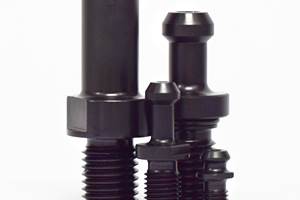The Benefits and Limitations of Machining With an Angle Head
Far from being outdated by the latest machine tool technology, angle heads often prove an ideal complement by pushing done-in-one capabilities even further. Proper application, however, requires attention to their limitations as well as their benefits.
Share






Even amid the ongoing proliferation of increasingly sophisticated multi-axis machine tools, the relatively simple angle head still plays a critical role in the production of complex-geometry parts. That’s the picture painted by sales data from Big Kaiser Precision Tooling, which reports robust use of angle heads among aerospace and energy industry customers in particular. During a recent presentation, engineering and product manager Alan Miller covered the advantages and the limitations of these tried-and-true accessories.
By adding another axis to an existing machining center, an angle head enables the tool to reach part features that would otherwise be inaccessible. That’s a key advantage for aerospace manufacturers contending with increasingly stringent delivery and accuracy requirements for parts with more sculpted, curved geometry than ever before. To meet that demand, these shops often turn to five-axis and multitasking machines that can eliminate multiple setups and the associated potential for stackup error. Still, without an angle head, features like internal scallops can prevent single-setup production on even the most flexible equipment, Mr. Miller says. Other parts, particularly in the energy industry, have complex internal features that could be impossible to produce any other way, even with multiple setups.
Given these possibilities, manufacturers often have high expectations for angle heads—expectations that must sometimes be tempered. It’s important to remember that an angle head is a spindle attachment, not a direct output from the spindle, Mr. Miller says. As such, its rigidity is inherently limited, as are horsepower and thrust (even the heaviest-duty units are limited to about 5 hp). Thus, users should take care with chip loads and cutting depths, and aggressive climb milling techniques with carbide tools simply aren’t practical in applications involving any material harder than 40 HRc. Conventional milling with high speed steel cutters is a better option to avoid deflection or chipping the tool. “If you could do it on a knee mill, an angle head can probably handle it,” Mr. Miller says. “But if it’s something that’s going to take a 20-hp cut on a milling machine to pull off, you should probably rethink what you’re doing.” He adds that cycle times should be limited to about 30 minutes with an angle head running anywhere close to maximum speed because the units rely on external coolant.
After determining that an angle head is a viable option, customers often raise questions about programming, Mr. Miller says. Although most CAM systems have built-in functionality for angle heads, users should keep in mind that many software packages use the older term “aggregate heads” to refer to the attachments. Shops without a CAM package can employ canned cycles as long as the machine’s CNC offers the functionality to select the proper plane for cutting. On FANUC controls, for example, axes can be “flipped” using the G17, G18 and G19 commands. The G68 command can also adjust the machine coordinate system if the head is not set up along a common machine axis, although he points out that this is much more complicated. Without a CAM system or a CNC capable of the aforementioned functions, programming by hand using G1 commands is the only option. In that case, macros can provide significant time savings if the same head is employed repeatedly in the same types of applications.
Another common difficulty with implementing angle heads involves stop blocks, which mount to the spindle and engage with the head’s locating pin to prevent it from rotating out of place during operation. These accessories require a precise fit with the spindle of a particular machine model, and attaining that fit often requires working with customers to design and dimension custom subplates, Mr. Miller says. Typically, proper mounting locations, bolt hole patterns and other needed dimensions can be found in the machine’s manual. The fact that many machine tool builders have standardized on pin designs from Big Daishowa, the Japanese designer of Big Kaiser’s angle heads, makes this process easier, he notes.
Far from being outdated by the latest machine tool technology, angle heads can push done-in-one capabilities even further. Proper application, however, requires attention to their limitations as well as their benefits.
Related Content
Big Daishowa Toolholder Increases Precision for Lathes
The Big Capto C3 series provides higher rigidity to minimize vibrations and movement during cutting, improving accuracy and efficiency.
Read MoreRego-Fix’s Center for Machining Excellence Promotes Collaboration
The new space includes a showroom, office spaces and an auditorium that will enhance its work with its technical partners.
Read MorePlatinum Toolholding System Enables Quick Changeovers
The U-Tec changing system enables a standard ER output live tool to accept various adapters for different applications, enabling quick changeover of tools on almost any lathe or mill using a single tool.
Read MoreT.J. Davies Retention Knobs Maximize Cutting Tool Life
Custom-made retention knobs are sized to fit the machine tool and spindle or toolholder to extend the life of existing machine tool assets.
Read MoreRead Next
AMRs Are Moving Into Manufacturing: 4 Considerations for Implementation
AMRs can provide a flexible, easy-to-use automation platform so long as manufacturers choose a suitable task and prepare their facilities.
Read MoreMachine Shop MBA
Making Chips and 91±¬ÁĎÍř are teaming up for a new podcast series called Machine Shop MBA—designed to help manufacturers measure their success against the industry’s best. Through the lens of the 91±¬ÁĎÍř benchmarking program, the series explores the KPIs that set high-performing shops apart, from machine utilization and first-pass yield to employee engagement and revenue per employee.
Read More





















